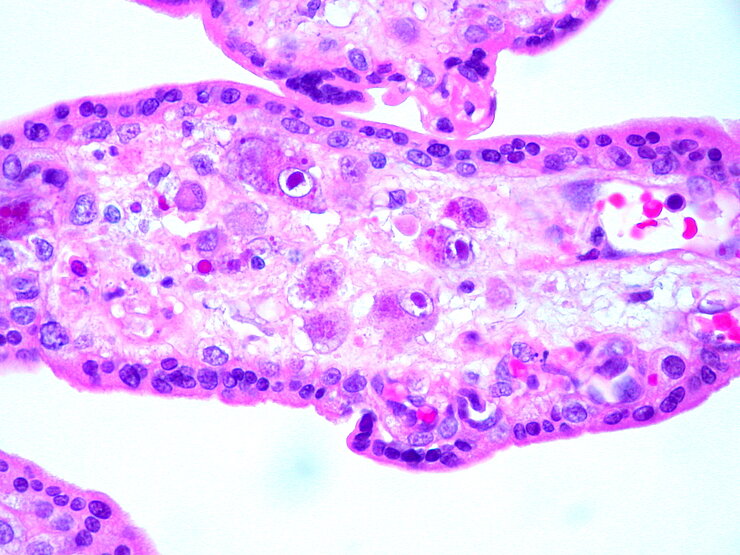Herpes Viruses - A Large Family
When we think of herpes, we usually think of small blisters on the lips caused by Herpes simplex virus type 1 first. But the family of herpes viruses is known to consist of more than 200 relatives of which nine are specific to humans.
These human herpes viruses (HHV) include Herpes simplex Viruses types 1 and 2, Varicella zoster virus, Epstein-Barr virus, cytomegalovirus, human Herpes viruses 6A, 6B and 7 as well as Kaposi's sarcoma-associated herpes virus. The diseases triggered by herpes viruses include labial and genital herpes as well as chickenpox, shingles, mononucleosis and various cancer diseases. Although the symptoms of many of these diseases can be treated effectively, herpesviruses cannot be put out of action.. Vaccinations are available only for protection against Varicella zoster virus.
Herpes viruses have accompanied man for millions of years and have adapted very well to humans. Once an infection occurs, the herpes virus remains in the body for life. This means that every adult human is a carrier of one or more of the nine herpes viruses. After the initial infection, which often is free of symptoms and remains undetected, the herpes viruses switch to a so-called stage of latency. No new virus particles are produced in this phase and the virus is not recognised by the immune system at all or only with much difficulty. Only upon reactivation, which may be caused by a weakened immune system, the virus proliferates in the body and symptoms of disease may become manifest. However, reactivation may also occur without obvious symptoms to the afflicted individuals, although the herpes virus proliferates and is shed such that transmission to other people is feasible.
The immune system can be weakened by a variety of causes. Even just a common cold weakens the immune system, because it keeps it "busy". Negative emotions, strong physical strain, stress or genetic defects are other factors that can weaken the immune system. People afflicted by immunodeficiency diseases such as AIDS are particularly susceptible in this regard, as are transplantation patients, whose immune system is suppressed by medication in order to prevent rejection of the graft.
Herpes simplex Virus - The Ubiquitous Virus
The best-known herpes virus in the general population probably is Herpes simplex virus (HSV). There are two types of this virus: Herpes simplex virus type 1 (HSV-1) and type 2 (HSV-2).
- According to estimates of the World Health Organization WHO, two thirds of all people in the world are infected by HSV-1. HSV-1 is the main cause of the blister-like rash on the lips and is transmitted mainly via saliva.
- In contrast, HSV-2 is the most frequent cause of genital herpes and is mainly transmitted by sexual routes.
However, on principle, both HSV-1 and HSV-2 can cause labial herpes and genital herpes. In rare cases, HSV-1 can cause a life-threatening Inflammation of the brain (encephalitis). There is no effective protective vaccination against either of these herpes simplex Viruses, and treatment can only alleviate the symptoms.
Varicella zoster Virus - A Two-Pronged Hazard
Varicella zoster virus (VZV) is responsible not only for one but for two diseases:
- Chickenpox (Varicella) and
- Shingles (Herpes zoster).
After initial exposure, which usually occurs in childhood, VZV causes chickenpox. This disease commences with itching exanthema and fever and can lead to skin lesions, which then develop into blisters. The severity of these lesions can vary strongly between individuals. Usually, these skin lesions subside without any scars, but scratching or secondary Infection by bacteria can lead to scarring.
Chickenpox can be a serious disease in neonates, pregnant women and people with a weakened immune system. For example this can lead to Varicella pneumonia, i.e. inflammation of the lung, or secondary infections by bacteria. Most of these bacterial secondary infections are caused by Streptococcus pyogenes or Staphylococcus aureus and can lead to diseases such as Sepsis, skin infections or pharyngitis.
Diseases of the central nervous system manifest more rarely, but may be fatal. If a pregnant woman becomes infected by VZV for the first time during the first or second trimester, an Infection of the foetus in the womb may be caused, which can lead to miscarriage or severely damage the child. There is another risk if a mother is afflicted by a Varicella disease at about the time of birth - the Infection of the child can lead to life-threatening neonatal varicellae in this case.
For this reason, the Standing Vaccination Committee of the Robert Koch-Institute has been recommending, since 2009, the two-dose Varicella vaccination of children, adolescents, non-vaccinated women of childbearing age and women of childbearing age with an unclear vaccination status. HZI scientists were able to show that the Varicella vaccination fortunately is not associated with an increased shingles risk.
Once the chickenpox subsides, the VZV persists in a latent stage in the nerve cells for life and can be reactivated and trigger shingles at a later point in life. In Germany alone, more than 400,000 people are afflicted by shingles each year. Usually, this disease initially manifests with burning nerve pain, followed by a blister-like rash, most often on the chest and trunk, but also on the head and legs.
After the skin rash heals, the nerve pain (so-called post-herpetic neuralgia) may persist in the previously affected skin region for a long period of time - for several years in the worst case. For this reason, early pain therapy to go along with the antiviral therapy is recommended. Patients from the age of 50, who are afflicted by shingles to an increased degree, can be vaccinated with the Herpes zoster Vaccine. This has been available in Germany since 2013. But it does not provide full protection from shingles in all cases.
Still, the vaccination is very beneficial, because a herpes zoster disease manifesting despite vaccination will usually have a less severe course and be associated with clearly less nerve pain and more rarely turns chronic. While the first approved Herpes zoster vaccine was a live vaccine and therefore not suitable for people with a weakened immune system, an inactivated vaccine is now also available. Since December 2018, this inactivated vaccine has been recommended for all people aged 60 and over (risk groups from the age of 50).
Cytomegalovirus - An Inseparable Companion
Cytomegalovirus (CMV) is one of the most widespread herpes viruses as 40 percent of all adults in Germany and more than 90 percent of all adults in developing countries are infected by this virus. The initial infection by CMV is usually harmless and free of symptoms. But in immuno-suppressed people, like transplantation patients, a CMV Infection can cause serious complications and damage to organs such as the lungs, liver or eyes.
If a CMV-negative patient receives an organ from a CMV-positive donor (in which the virus is present and transmitted by the transplantation), there is a very high probability of rapid proliferation of CMV in the body of the recipient. The reason: The immune system of the recipient has not yet acquired CMV-specific immunity since it never experienced a CMV Infection. Moreover, the immune system of the recipient is weakened by medication in order to prevent the rejection of the transplanted, i.e. foreign, organ - this strongly impairs the ability of the immune system to establish a CMV-specific defence.
Another complication is evident in bone marrow transplants: CMV-positive recipients receiving bone marrow from a CMV-negative donor experience an elevated risk of a CMV Infection, since the donated bone marrow has no immunity against CMV and the inherent bone marrow containing the information for the CMV-specific Immune defence was destroyed before the transplantation.
Children infected by CMV in the womb are also at special risk. In unborn children, CMV can cause hearing impairment or skull deformity, so-called microcephaly. This form of skull deformity in neonates made the news in the Spring of 2016 because it can also be caused by infection by the Zika virus.
HHV-6 and HHV-7 – Two Major Unknowns
Human herpes viruses 6 (HHV-6) and HHV-7 are very close relatives of CMV.
- There are two types of HHV-6: A and B. HHV-6 and HHV-7 a very widespread as more than 85 percent of all adults are carriers of these herpes viruses. HHV-6B is the main cause of a very common childhood disease, so-called tertian fever also known by the names of roseola infantum or exanthema subitum. It can manifest as a skin rash in the face and trunk that can spread to the lower extremities when the fever gets better. Other symptoms can include diarrhoea, coughing and swelling of the lymph nodes. This disease with its rather mild course becomes manifest mainly in children between six and 24 months of age, and can just as well show no symptoms at all.
- HHV-7 also causes exanthema subitum and is associated with spasms in small children. Exanthema subitum caused by HHV-7 can be associated with high fever and neurological symptoms may be evident.
Specific clinical patterns for HHV-6A have not been reported yet. As is true of all herpes viruses, infections by HHV-6 and HHV-7 take a more severe course in people with a weakened immune system.
EBV and KSHV – The Tumour Viruses amongst the Herpes Viruses
Two human herpes viruses are closely associated with cancer diseases. Both Epstein-Barr virus (EBV) and Kaposi's sarcoma-associated herpes virus (KSHV) can cause tumours. While EBV is one of the most widespread Viruses worldwide, KSHV is present at varying levels in different regions of the world. By the time they reach their early 50s, 95-98 percent of all humans have experienced an EBV Infection. EBV is the cause of infectious mononucleosis, also known as glandular fever. If the EBV Infection takes place in early childhood, it usually becomes manifest with no or only mild symptoms.
But if the initial EBV infection takes place as late as in adolescent or adult age, the symptoms are usually much more pronounced and range from fatigue, fever, headache and pain in the limbs and throat to swollen lymph nodes and an enlarged spleen. EBV is transmitted very easily by saliva, but also upon contact with blood or by sexual contact, blood transfusion or transplantation. In people with a compromised immune system, an EBV Infection can be a serious disease. It can be associated, for example, with an Inflammation of the central nervous system, lung, pancreas or heart. In addition, EBV can cause a number of malignant cancer diseases such as nasopharyngeal carcinoma or lymph tumours such as Burkitt's lymphoma or Hodgkin's disease.
KSHV is particularly widespread in some regions of Africa where more than 40 percent of the population may be infected by this virus. The incidence in North America and Europe is much lower (less than ten percent of the population). Only rarely does KSHV cause tumours in people whose immune system is intact. In immuno-suppressed people, though, it can cause Kaposi's sarcoma, the most common tumour in AIDS patients, as well as primary effusion lymphoma (a B cell lymphoma) and multicentric Castleman disease. In Africa south of the equator, the course of Kaposi's sarcoma is very aggressive and associated with high morbidity and mortality.
It is generally true that pathogenic human herpes viruses have adapted very well to humans and have developed effective strategies that allow them to evade the Immune defence and possibly even utilise it for their own purposes. Since vaccines are available against only one of these viruses and the medications available today have adverse effects and may contribute to the emergence of resistant mutant viruses, it is very important to develop effective vaccination strategies and antiviral therapies. HZI scientists are investigating the details of how herpes viruses affect the immune system and how they manage to persist in their Host for life. Based on these insights, the scientists aim to advance the development of new agents and therapies in order to ultimately win the fight against herpes virus-caused diseases.
(rwi, joh)





